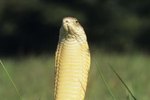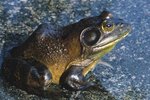
Green anacondas (Eunectus murinus), the world's largest snakes, and their close relatives, the smaller yellow anacondas (Eunectus notaeus), live solitary lives. Green anacondas inhabit tropical lowlands throughout South America and yellow anacondas the swamps and marshes in southern parts of the continent. From March to May, these giant boa constrictors abandon their hermit ways and spend weeks, months even, in courtship and mating. For some male green anacondas these mating marathons will end in death.
Males Seeking Females
It's the males, of both anaconda species, who leave their home ranges and go in search of females that are ready to mate. Female anacondas may leave a trail of pheromones for the males to follow. They may also release pheromones into the air, as they've been observed stationary, with males coming from all directions toward them. How the males track the female anacondas isn't fully understood, but the males flick out their forked tongues, collecting scents from the ground and air, which are transferred to their Jacobson's organs in the roofs of their mouths. The Jacobson's organ enables snakes to smell and locate their prey, and males to smell receptive females.
Breeding Balls and Seduction
Green anacondas are polyandrous -- where a female mates with multiple males -- and two to twelve males may gather round a single female anaconda. They form a mass of writhing bodies called a breeding ball, and the male snakes push against each other as they compete to get to the female. During courtship, the males search for the female's cloaca, her genital and excretory opening, while stroking her with their spurs -- remnants of hind limbs. The female, stimulated by the males' spurs, lifts her cloaca to come together with the successful male, and they mate with his tail coiled around her. Breeding balls can stay together for up to four weeks, and the female may breed with several of the males during that time. Yellow anacondas sometimes form breeding balls, but are generally sequentially monogamous, mating with a number of anacondas, but one at a time.
Size isn't Everything
Generally the larger males get to mate with the largest and most fertile female anacondas. However, the female anacondas of both species are considerably bigger and stronger than the males, and it's the females who ultimately choose which males they breed with. While in breeding balls, some very large males may miss out on mating as they get mistaken for females and courted by the other male anacondas.
Cannibalism and Mating
Records of cannibalism among green anacondas are usually of large females ingesting smaller males. After mating, females sometimes eat one or more of the males from the breeding ball. This extra food may help the female green anacondas survive their long gestation when their ability to move about and forage is limited.
After Mating
When mating is finished, the males of both species return to their home ranges. The impregnated females are ovoviviparous and incubate their eggs -- the young are in clear membranes -- inside their bodies. Gestation lasts six to seven months and they give birth in the water to up to 82 live young, with an average of 20 to 40 offspring. The young are independent from birth and receive no parental care. Yellow anacondas breed annually, but female green anacondas only breed every other year to recover the energy lost through reproduction. The young of both species and sexes, if they survive, will be 3 to 4 years old before they're sexually mature and can mate.
References
- Animal Diversity Web: Eunectes Murinus Anaconda, Green Anaconda
- Animal Diversity Web: Eunectus Notaeus Yellow Anaconda
- Jacksonville Zoo and Gardens: Bio Facts: Anaconda, Green
- Anacondas; Anne Welsbacher
- San Diego Zoo Animals: Reptiles Anaconda
- Reptiles and Amphibians; Mark O'Shea and Tim Halliday
Photo Credits
-
Tom Brakefield/Stockbyte/Getty Images




